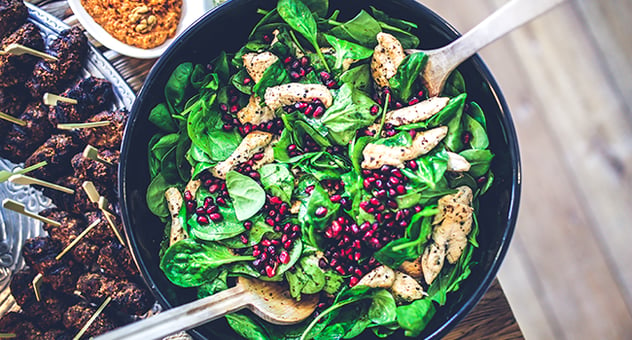For many reasons, profit can slowly disappear in our F&B establishments, a big reason for that can be hidden in the food cost. Consider what food cost is made up of - we buy food, we store it, change it with a recipe and in turn, sell it on to our customers.
Ingredients for the dishes we produce can take a complicated route though our establishments before being served to our customers, and sometimes we don’t realize it!
So, what can we do to change, or lower food cost? Here are 10 tips you can use to reduce your food costs.

1. Maintain price, reduce portion size
Sit down with your food menus, list each and every menu item you offer and then start analyzing the ingredients and portion sizes. Are there any options to consider that would make any of your menu items better performers and help maximize revenue?
When decreasing portion sizes, consider the potential impact on your customers. Would this option create favorable results with your food cost? Will it t alienate your customer base? (because they think they are getting less value for their money)
2. Change your recipe composition
This might be a good opportunity to pull the recipes off the shelf, go through them by ingredient and see if there are any changes to be made or updated. As noted, any changes here will affect your bottom line and not always in the way you expect.
If there are too many alterations too often, your customers will sense it and you may risk losing them altogether. A lower COS (cost of sales) will have no meaning if you have fewer customers as a result of the changes you have made.
3. Adjust product quality
Look at all the purchasing specifications on each of the menu ingredients. How would any changes at this level affect the buying, production, or service cycles in your establishment?
For example, pre-washed romaine lettuce (for your salad dishes) could allow cost savings, as there would be a higher product yield as there would be less waste and certainly lower labor cost
4. Ensure everything is sold, no waste
Test your control processes. Have a look at the nine traditional control areas (as below) and see if there are any weak links in your processes to the point where your deposits are made at the bank.
There is potential here in these nine control points to tighten processes, helping you better control your food cost. Just to review, the nine control areas are:
1. Purchasing
2. Receiving
3. Storage
4. Inventory handling
5. Issuing from storage areas
6. Production
7. Service
8. Sales
9. Cash control
5. Look at your sales mix
Build in a better sales mix with higher and lower-cost menu items (servers should get this knowledge as a part of their training!). Menu items never have the same food cost, meaning that each item will have a different financial contribution from the next.
Up-selling, done well can mix and match your menu items, if a customer selects a menu item with a relatively high individual food cost, servers should be attuned to this and suggest some add-ons, alternatives or accompaniments with a lower cost of sales. It means your revenue increases and your cost of sales should fall.
6. Maintain portion size, increase selling price
This can be a tricky one. Don’t arbitrarily increase prices (and never with white-out or tape on your old menus) If you are going to raise menu prices, reprint the menu.
It’s best to remove that menu item all together and then adjust the price in your next menu cycle with a new price at a later date. When doing this ensure that your customers will still get value for what they’re paying, you don’t want to lose them because of unreasonable prices.
7. Track your food cost daily
This one is a bit of work to set up but once you have it, you can monitor your food cost on a daily basis. Let’s say your food inventory turnover is about 3 - 4 times per month, use your daily food purchases as your daily cost of sales compared to your daily revenue, don’t forget to get the month-to-date figures in there too.
The first 2 or 3 weeks will be wonky, but by week 3 and into week 4 your month-to-date cost gives a surprisingly accurate indicator of where your food cost is going for the month! A spreadsheet is a simple way to track your numbers, and not hard to manage once you see the patterns.
8. Use your data to track trends
Here are some common ones:
- Average guest check for each meal period and the day?
- Average food sales per seat?
- Average turnover per seat?
Whereas these are not a direct reflection of food cost, they do help you to identify any trends in your business. Identifiable trends allows you to plan and by being able to plan means that you can start to control your food cost as well as better plan your profitability. (Here’s labor cost again! These stats should also help you trim labor cost and help monitor employee productivity!)
9. Talk to your suppliers
You are the expert at running your business; your suppliers are the experts at sourcing better prices and better-quality products, certainly on a seasonal basis. In many ways, your suppliers can have the biggest impact on the profitability of your menu items by highlighting the best, most readily available products at the best price in the best season. Let them do their job so you can do yours!
Sit down and talk to your suppliers at least three times a year formally to review and more frequently informally. Don’t forget that you are your supplier’s customer, meaning that if your business is successful, so is theirs!
Suppliers often have as much at stake as you do in your business, work with them and let them help you with your planning and purchasing. Don’t give them “carte blanche,” learning to work with suppliers effectively will go a long way to helping you control and predict your food cost.
10. Train your staff on inventory
Food costs (or cost of goods sold) can typically account for around 30% of a restaurant's costs. It is an important area to control. Train your staff on why inventory is taken and how to do it correctly. Use a consistent inventory count sheet to help make it easier.
Absolutely, reconcile your food costs monthly, but try to do a food cost sampling on a weekly basis to check your assumptions of look for trends, favourable or otherwise.
It also shows your staff it’s an important area to look at and they will in turn see it as important as well. You need clear data to help you make business decisions daily, you likely know what your daily labor cost is, track your food cost as well.

Some of these 10 tips are quicker to accomplish than others, some need a bit of time to collect the data so that your statistics become meaningful for you.
Take your time, be methodical and by putting the pieces together with your team you can have a positive impact on your business and see reductions in your food cost and a better controllable profit.
Best of luck with your resolve to run a tighter, more profitable F&B establishment!
Learn more about managing your food costs, and take our course. Start now!
 |
Mike Walmsley, is the author of '69 Tips For Better Food & Beverage Profit'. Stay tuned for the next book in the series, '101 More Tips For Better Food & Beverage Profit', coming out soon on Amazon! |
You might also like: